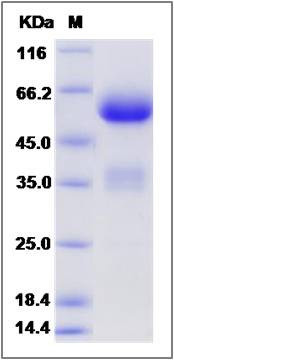Human PIK3IP1 Protein (Fc Tag)
HGFL,hHGFL(S)
- 100ug (NPP2409) Please inquiry
| Catalog Number | P13928-H02H |
|---|---|
| Organism Species | Human |
| Host | Human Cells |
| Synonyms | HGFL,hHGFL(S) |
| Molecular Weight | The recombinant human PIK3IP1/Fc is a disulfide-linked homodimer. The reduced monomer comprises 388 amino acids and has a predicted molecular mass of 42.7 kDa. The apparent molecular mass of the protein is approximately 55 kDa in SDS-PAGE under reducing conditions. |
| predicted N | Ser 22 |
| SDS-PAGE |  |
| Purity | > 85 % as determined by SDS-PAGE |
| Protein Construction | A DNA sequence encoding the human PIK3IP1 (AAH11049.1) (Met1-Thr168) was expressed, fused with the Fc region of human IgG1 at the C-terminus. |
| Bio-activity | |
| Research Area | Immunology |Signal Transduction |Protein Trafficking |Vesicle Transport |Adapters |Transmembrane | |
| Formulation | Lyophilized from sterile PBS, pH 7.4 1. Normally 5 % - 8 % trehalose, mannitol and 0.01% Tween80 are added as protectants before lyophilization. Specific concentrations are included in the hardcopy of COA. |
| Background | PIK3IP1 contains 1 kringle domain and is a negative regulator of phosphatidylinositol-3-kinase (PI3K), suppresses the development of hepatocellular carcinoma. PI3K is a well-known regulator of cell division, motility, metabolism and survival in most cell types. Proper liver function and development highly depend on intact PI3K signal transduction. Aberrant PI3K pathway signaling in the liver is associated with hepatocellular carcinoma. PI3K signaling is involved in the homeostasis of lipid and glucose metabolism. Activation of the PI3K pathway induces lipogenesis and glycogenesis in the liver, since both Akt overexpressing transgenic mice and PTEN knockout mice develop fatty liver and hypoglycemia. PIK3IP1 overexpression can contribute to glucose homeostasis and fatty deposition. |
| Reference |
